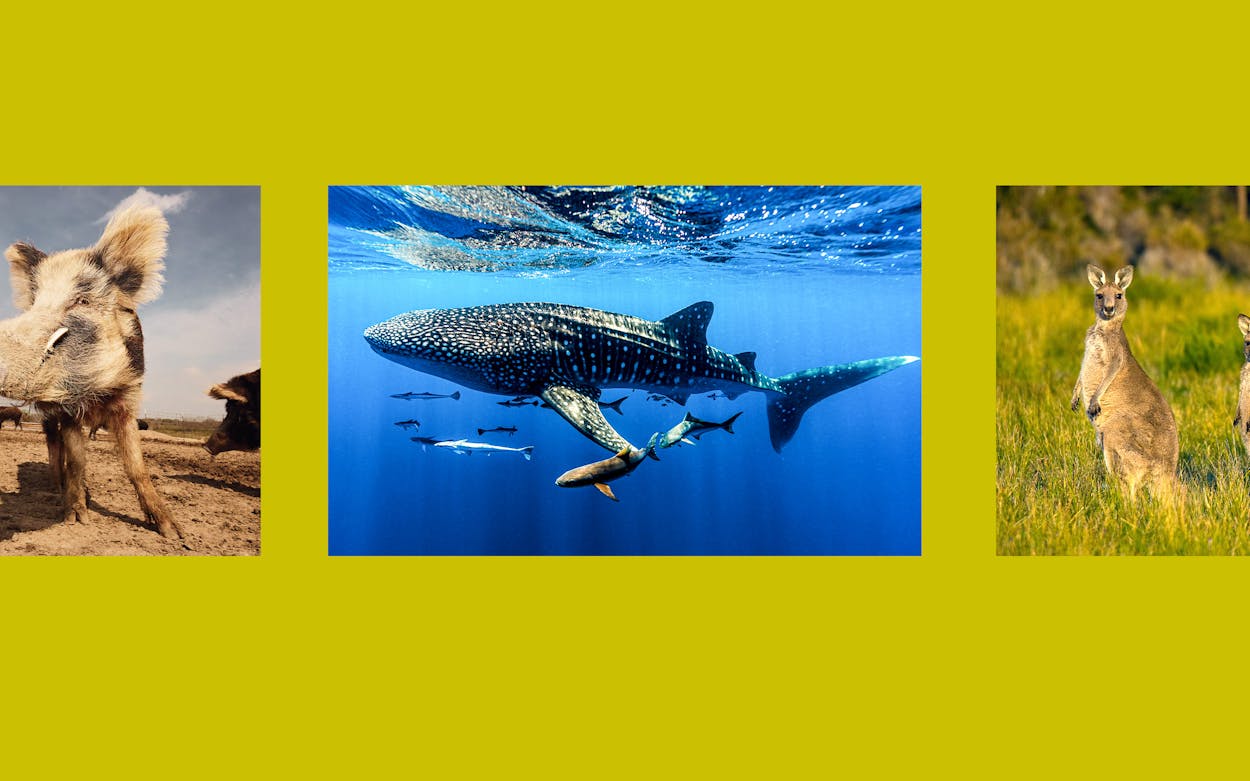Texas Monthly went big on the critter beat this year. We published sixty stories about animals in 2023, more than ever before. Our coverage of furred, feathered, and fanged subjects ranged in tone from serious to silly. We tracked a troubling crime spree at the Dallas Zoo and dove deep into the contentious debate over mountain lion conservation—but we also congratulated Mr. Pickles, an elderly tortoise in Houston, on becoming a dad, and even penned a steamy romance between a grackle and a tennis ball. The battle against invasive species was a major theme, with TM writers introducing readers to the creatures that plague us (feral hogs, fire ants, and beetles) and those that have been enlisted to fight back (dogs and goats). You probably missed some of them, so below, we’ve rounded up ten of our very best animal stories. We’ve ranked them in order from cutest to creepiest, because, well, why not? (If you’re squeamish, maybe don’t read all the way to the end—or at least finish your lunch first.) And for even more wildlife stories, sign up for our new Critter of the Month newsletter.
1. Goats
It was a big year for ruminants. Lauren Larson, a former TM staff editor turned freelance goat correspondent, penned not one but two very funny goat stories. First, she explored the hot new wedding trend of the year: goat crashing, in which brides- and grooms-to-be can hire a herd to charm guests at their outdoor reception. Later in the year, she reported on the booming business of hiring goats for landscape management. “Goats’ four stomach chambers enable them to digest material that flummoxes people, digestively and logistically,” Larson wrote, “making them valuable soldiers in the constant war against uninvited flora.”
2. Snow Monkeys
In 1975, writer-at-large Sarah Bird cuddled a Japanese snow monkey in her lap on a dusty ranch near Laredo. Pelka was one of 176 macaques that had been airlifted from the mountains outside Kyoto, “from the Land of the Rising Sun to the Land of the Roasting Sun,” where they found sanctuary. Their descendants are still living in Texas today. Nearly a half-century after her first encounter, Bird went searching for Pelka’s offspring and took readers along on a winding, wild monkey saga. This is one of those immersive longreads to enjoy on a lazy Sunday morning with a cup of coffee.
3. Kangaroos
After two pet kangaroos went walkabout in North Texas in as many weeks, Charlie Scudder asked why our state is home to so many kangaroo escapes. The answer: Texas’s unusually lenient exotic animal laws make it easy to keep a ’roo here (not that you should!), plus the Australian marsupials are very well-suited to our climate. “Texas is great for them, because they love the heat,” said ranch owner Cassidy Jagger.
4. Whale Sharks
“It’s like the Holy Grail” when you find the elusive whale shark, NOAA fisheries biologist Eric Hoffmayer told Juli Berwald. The world’s biggest fish is rarely seen in Texas waters, but fishing guides on a charter boat off Port Aransas had a magical encounter in August. Since these gentle giants are so hard to find and study, researchers still have a lot to learn about them—but a cutting-edge digital tool called Sharkbook, which uses each creature’s unique spots to identify individuals, is helping.
5. Blue Sea Dragons
Senior editor Emily McCullar memorably described the blue sea dragon as looking “like a cross between the Pokémon Gyarados and the blue liquid used in a sanitary pad commercial.” The vibrantly colored inch-long sea slug falls into the sizable category of weird things that wash up on Texas beaches and may cause mild to moderate pain if you pick them up: “These living tchotchkes can pack a punch even more potent than that of the better-known Portuguese man-of-war.”
6. Indigo Snakes
Asher Elbein went snake-hunting in the thornscrub of the Lower Rio Grande Valley, hoping to glimpse Texas’s biggest snake. His first hike was unsuccessful, but persistence eventually paid off. “There it was: a four-foot indigo snake sprawled out in the wood chips, basking in the sun, its red-throated head raised slightly as it watched us,” he wrote. “For a moment we traded stares with the lord of the forest.” Farmers and ranchers respect the nonvenomous indigo snake because it preys on rattlers—a diet that helps this prodigious reptile reach five or six feet in length.
7. Feral Hogs
We at Texas Monthly humbly consider ourselves to be some of the finest pun purveyors in the journalism business. (Two all-time favorites: “Just Desserts,” a tale of fruitcake fraud, and “They Came. They Sawed,” on the making of The Texas Chainsaw Massacre.) Add another great one to the list with Lauren Larson’s “Apocalypse Sow,” the definitive account of how feral hogs took over Texas—and all the ridiculous ways folks are trying to stop them. That includes shooting hogs from helicopters while equipped with tactical night-vision gear, as well as employing various contraceptives, poisons, traps, and yes, tasty recipes for hog-centric dishes. Also fantastic are the photos of sly, muddy-snouted swine, one of which graced the magazine’s cover.
8. Alligator Snapping Turtles
Writer-at-large Sonia Smith’s “The Great Cajun Turtle Heist” is one of those stories that just has everything: true crime, a foggy swamp, a vanishing way of life, and a 171-pound snapping turtle named Brutus. Plus a special agent who wears a ten-gallon hat while chasing down wildlife criminals. That agent, Jim Stinebaugh, found much to admire in his quarry, poacher Larry James “Colo” Dietz. “He was almost like a man plucked out of the past, a Cajun from one hundred and fifty years ago,” Stinebaugh told Smith.
9. Hammerhead Worms
We’re still trying to figure out why, exactly, this profile of a slimy flatworm became our second-most-read story of the year. Was it the terrifying fact that when you try to kill it with a shovel, it just splits into two? Was it contributing senior designer Kim Thwaits’s spine-tingling illustration, in which dozens of the nasty buggers wriggle across your screen? Maybe it was the toxicity of the hammerhead worm, an invasive species that is slithering into Texas gardens and can make your hand go numb if you pick it up. Or perhaps just the word “worm.” Regardless, the hammerhead worm, by the mere fact of its existence, once again proves that life is simply stranger in Texas.
10. Texas Toe-Biters
Should the worm story leave you wanting more, may we suggest another creepy-crawly tale? This one has the added bonus of a first-person element. Associate editor Sasha von Oldershausen was swimming in a friend’s cowboy pool in Marfa when a big, brown insect appeared just below the surface. “Its pincers were built thicker than its legs,” she wrote. “I peered over my shoulder long enough to glimpse it, then clambered ashore with the resolve of the world’s first land animal.” It’s called the Texas toe-biter, though thankfully, no toes were bitten that day. Also known as a giant water bug or water roach, these guys, which a scientist affectionately called “flying syringes,” essentially drink their prey’s blood using a straw. So bizarre is this creature that, as we were editing the story, we almost missed this fun piece of trivia: “Another defense when disturbed is the giant water bug’s ability to squirt unpleasant smelling fluid from the anus for a few feet.” Cheers, y’all!
- More About:
- Critters








